Rennie Scaysbrook | October 4, 2018
Two Weeks With A Ratbag
Triumph’s Street Triple 765 is the cure for a boring life.
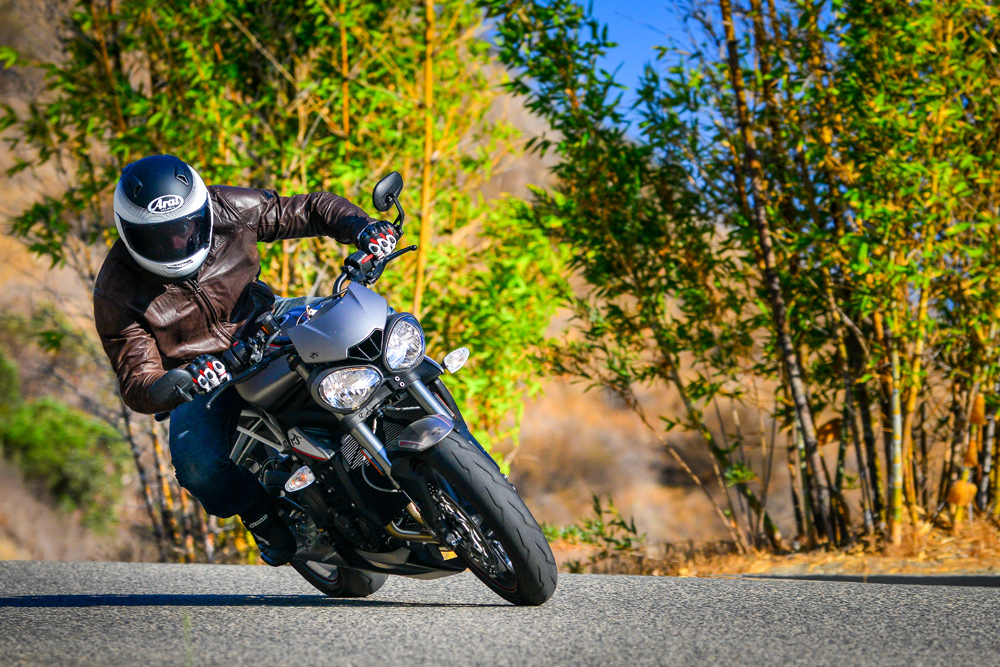 If you want a unique street bike that can carve canyons as easy as it can commute, the is your steed.
If you want a unique street bike that can carve canyons as easy as it can commute, the is your steed.
I’ll start this story with its conclusion, in case you’re strapped for time. The Triumph Street Triple 765 RS is the sort of bike everyone needs to ride at least a few times in their lives. It’s so damn fun, it should be illegal. It’s not the best street bike out there, but that doesn’t matter because the smile on your face will be wider than can fit between the cheekpads of your helmet.
Now, for how I got to that conclusion.
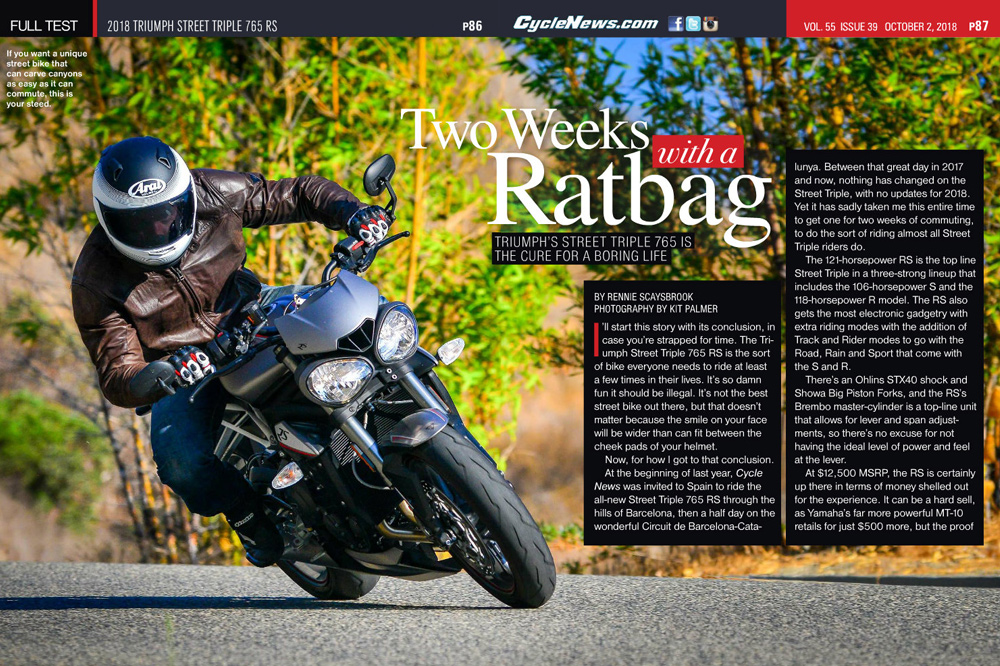
Photography by Kit Palmer
At the beginning of last year, Cycle News was invited to Spain to ride the all-new Street Triple 765 RS through the hills of Barcelona, then a half day on the wonderful Circuit de Barcelona-Catalunya. Between that great day in 2017 and now, nothing has changed on the Street Triple, with no updates for 2018. Yet it has sadly taken me this entire time to get one for two weeks of commuting, to do the sort of riding almost all Street Triple riders do.
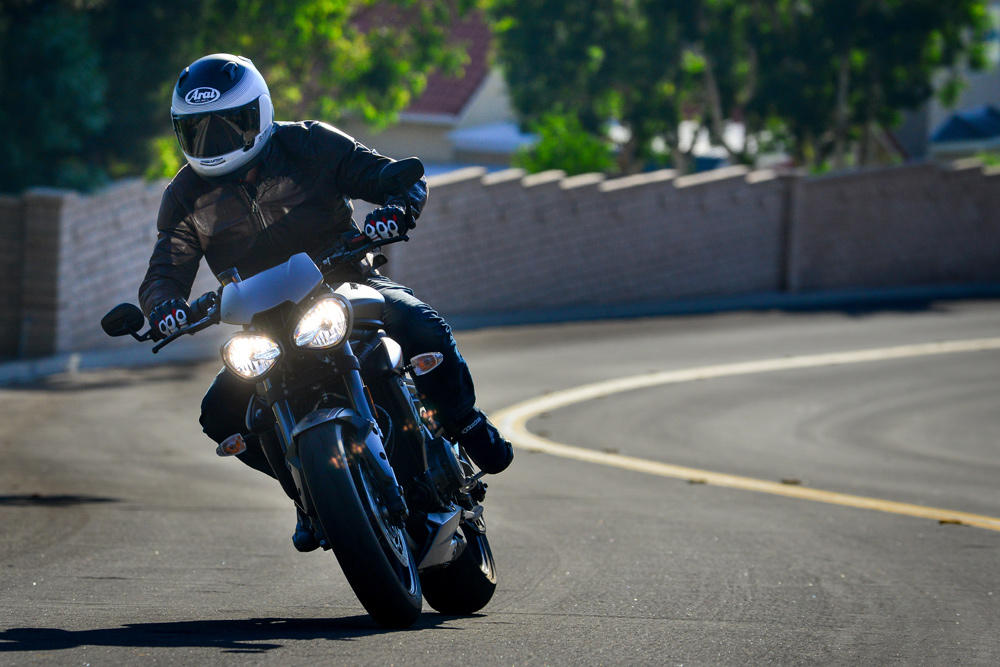 Even just getting to work, the RS is stupid fun.
Even just getting to work, the RS is stupid fun.
The 121-horsepower RS is the top line Street Triple in a three-strong lineup that includes the 106-horsepower S and the 118 horsepower R model. The RS also gets the most electronic gadgetry with extra riding modes with the addition of Track and Rider modes to go with the Road, Rain and Sport that come with the S and R.
There’s an Öhlins STX40 shock and Showa Big Piston Forks, and the RS’s Brembo master-cylinder is a top-line unit that allows for lever and span adjustments, so there’s no excuse for not having the ideal level of power and feel at the lever.
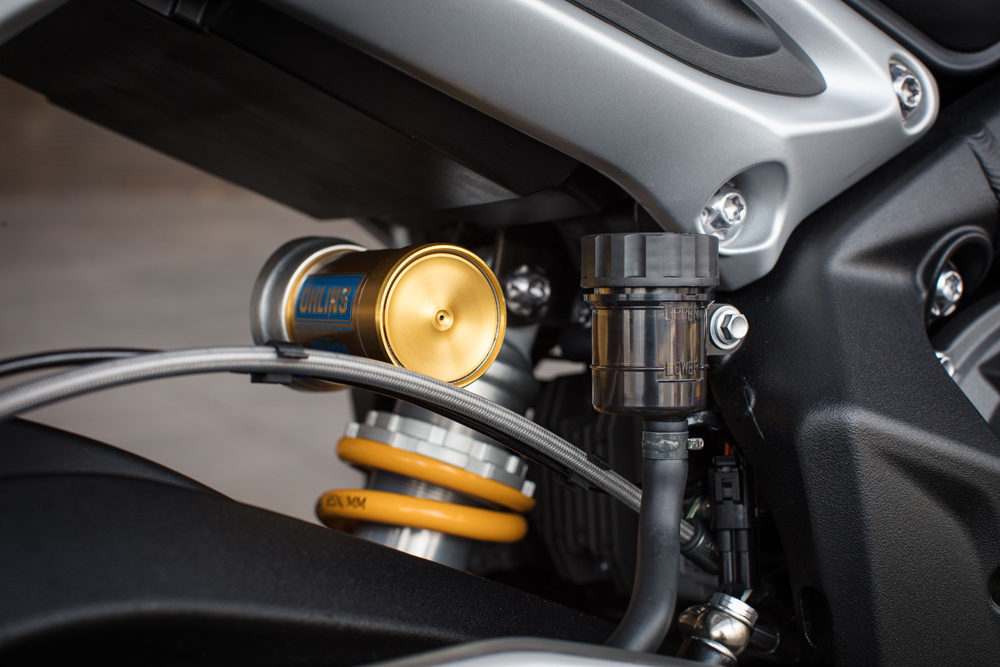 Ohlins suspension on the RS is beautiful but can be a touch hard, but it sure loves to be hustled.
Ohlins suspension on the RS is beautiful but can be a touch hard, but it sure loves to be hustled.
At $12,500 MSRP, the RS is certainly up there in terms of money shelled out for the experience. It can be a hard sell, as Yamaha’s far more powerful MT-10 retails for just $500 more, but the proof is in the ride experience. Battling traffic on an RS can be a thoroughly enjoyable experience—although you must be careful as the bars are about an inch wider at each end with the mirrors bolted to the bar-end—as the stupendous amounts of bottom-end torque make splitting between gaps incredibly easy, regardless of what gear you’re in. I tried this right up to fifth gear at no more than 15 mph, and with a tiny hesitation—which is to be expected—the RS pulled through two to five thousand revs cleanly and quickly, with one of the best induction sound tracks as back up.
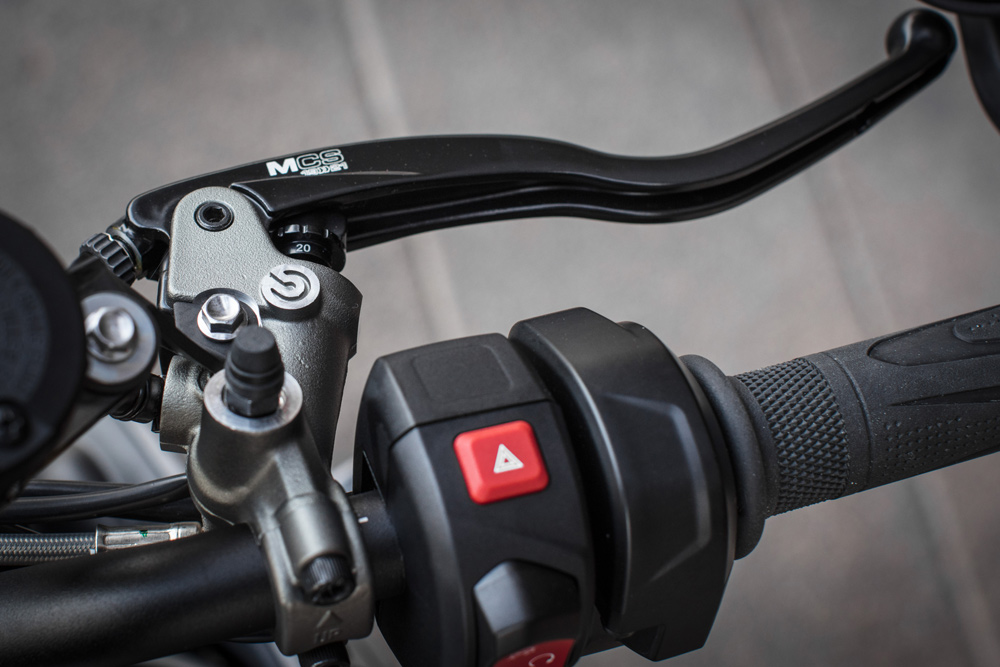 That Brembo master-cylinder setup is the same we had on our KTM Pikes Peak racer and worth every penny.
That Brembo master-cylinder setup is the same we had on our KTM Pikes Peak racer and worth every penny.
Interestingly, you still need to give the triple a proper rev off the line to ensure you’re in the right range for optimal acceleration. If you just let the clutch out from a stop and get on the gas, the engine loses a few hundred rpm before the building begins. If you want to get your holeshot on each time you leave the traffic lights, you’ll not encounter this problem. But for everyone else, this is something you’ll experience.
The extra capacity of the 765cc inline triple makes the old 675cc engine feel like it’s gone to the gym and hit the gear. As soon as the engine is spinning north of 3000 rpm, which is most of the time, there’s torque to absolutely burn. Equipped with an upshift-only quickshifter, the 765 will charge through the revs with the kind of urgency the old 675 could only dream of. On the downshift, you still need to use the clutch—I’d have loved if the quickshifter went both ways—but you won’t worry about it after a while because the gearbox is supremely smooth and I never had any miss shifts, regardless of how light-footed I was when selecting cogs.
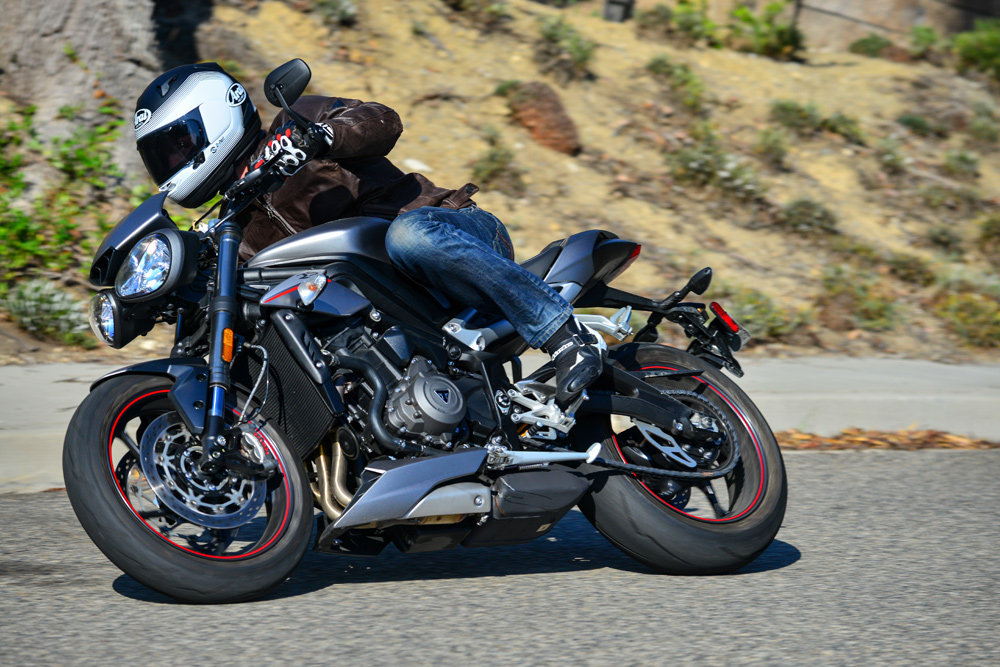 You’ll want to be careful not to rev the RS too loud in residential areas; she’s got some lungs on her!
You’ll want to be careful not to rev the RS too loud in residential areas; she’s got some lungs on her!
The ride position is excellent for quick blasts to work, but can be tiresome over longer rides. You cop every ounce of windblast on the RS, making it a tiring bike to ride after a few hours. And the suspension, while a dream for the track, is on the hard side for a production bike. Now, when I say “hard,” I don’t mean “harsh.” They are two very different feelings and the RS has excellent cornering and braking poise, it’s just that it doesn’t really love some of Southern California’s crappy road surfaces.
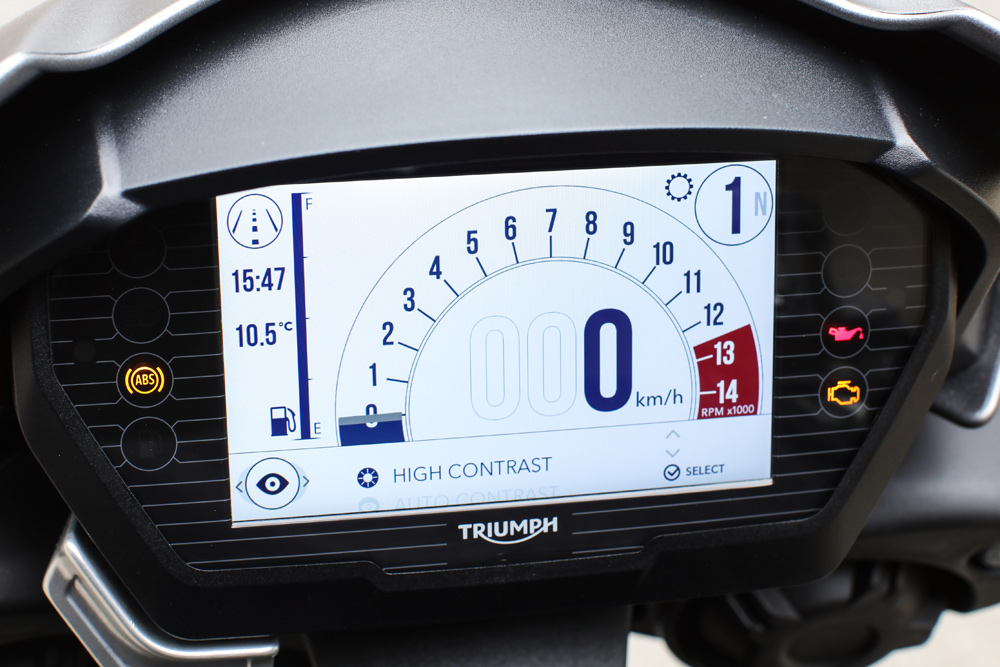 My favorite dash setup. There’re six to choose from!
My favorite dash setup. There’re six to choose from!
One thing I loved about the 765 at the intro last year was the dash. It’s a brilliant piece of computer engineering, offering six different layouts that range from full digital to quasi-analog. After a bit of faffing around I went for the digital speedo with the redline sweeping over the top. Half and half. And for the riding modes, considering I could have had the full gamut of Rider selectable, I more often than not found myself happy with just the Sport mode, which gave me a larger intervention of ABS, track settings for the TC and the Sport setting on the throttle.
The 765 is not a long-distance bike as the seat gets pretty hard after an hour, but the fact the bars are in such a relaxing position means you can stand up and stretch out easily without having to stop. And when you do stop, you may get as annoyed as I was on a few occasions as the sidestand can be a pain in the ass to get down with riding boots on. There’s no real latch for you to hook your boot on, so that’s something simple that needs fixing by Triumph.
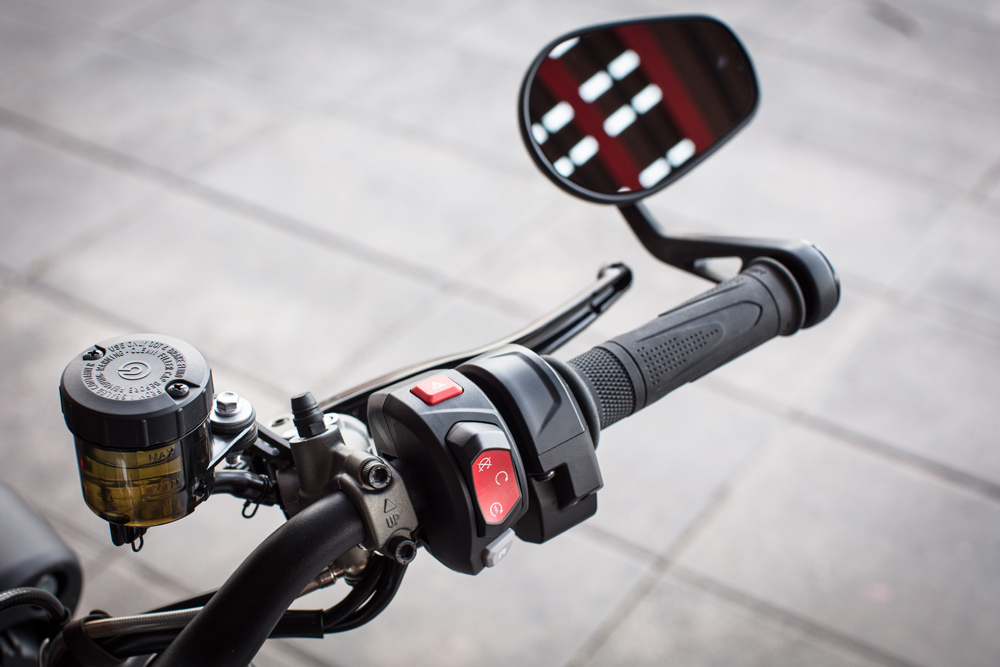 Mirrors look great and give a good view, although the can make the RS a bit wider when splitting lanes.
Mirrors look great and give a good view, although the can make the RS a bit wider when splitting lanes.
It sounds a bit lame, but my gripes with the 765 are only tiny ones. That side stand, those mirrors in traffic, the little drop in revs when you let the clutch out from stand still. Tiny things. That’s because the overall package is just so bloody good, I’d have one of these things in an instant.
So, for my final thoughts on the Triumph Street Triple 765 RS, read the first paragraph again. CN
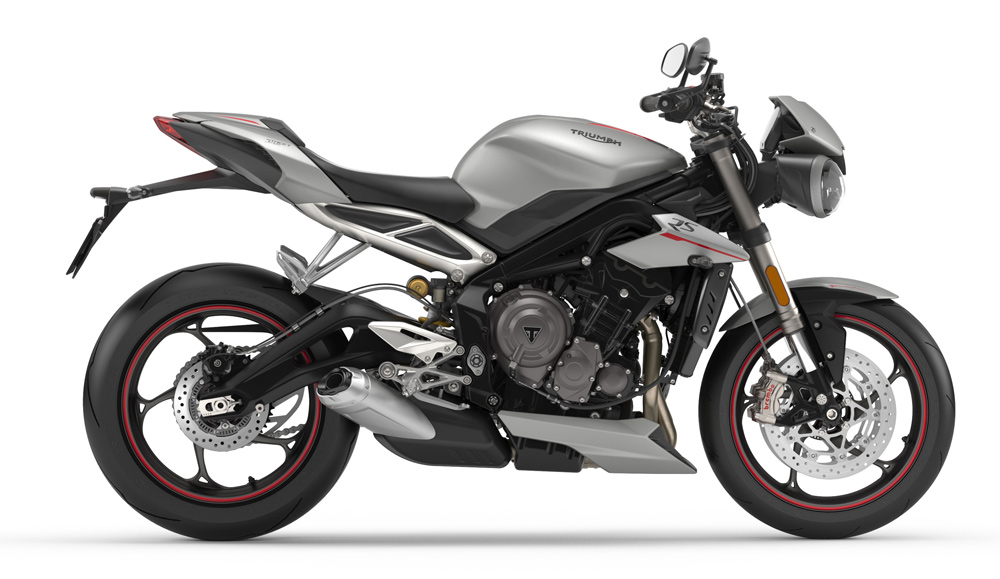
| SPECIFICATIONS |
2017 Triumph Street Triple RS ($12,500) |
| Engine: |
Liquid cooled, 4-stroke, 12-valve, DOHC in-line 3 cylinder |
| Displacement: |
765cc |
| Bore x stroke: |
78 x 53.4mm |
| Horsepower: |
121 hp @ 11,750 rpm (claimed) |
| Torque: |
56.8 lb-ft @ 10,800 rpm (claimed) |
| Compression ratio: |
12.65:1 |
| Fuel system: |
Multipoint sequential electronic fuel injection with SAI; Electronic throttle control; 5 throttle modes |
| Exhaust: |
3 into 1 |
| Transmission: |
6-speed gearbox; Quickshifter-equipped |
| Chassis: |
Aluminum beam twin spar |
| Front suspension: |
Showa 41mm USD big piston forks (BPF), adjustable compression damping, rebound damping and preload |
| Rear suspension: |
Öhlins STX40 piggyback reservoir monoshock, adjustable spring preload (lock-rings), compression damping and rebound damping |
| Front wheel travel: |
115mm |
| Rear wheel travel: |
131mm |
| Front brake: |
Twin 310mm floating discs, Brembo M50 4-piston radial monobloc calipers |
| Rear brake: |
Single 220mm fixed disc, Brembo single-piston sliding caliper |
| Front tire: |
120/70 ZR17 Pirelli Diablo Supercorsa SP |
| Rear tire: |
180/55 ZR17 Pirelli Diablo Supercorsa SP |
| Rake: |
23.9° |
| Trail: |
3.9 in |
| Wheelbase: |
55.5 in |
| Overall length: |
81.3 in |
| Seat height: |
32.5 in. |
| Fuel capacity: |
4.6 gal. |
| Weight: |
3.9 in. (dry, measured). |
| Color: |
Matt Ice Silver and Phantom Black |